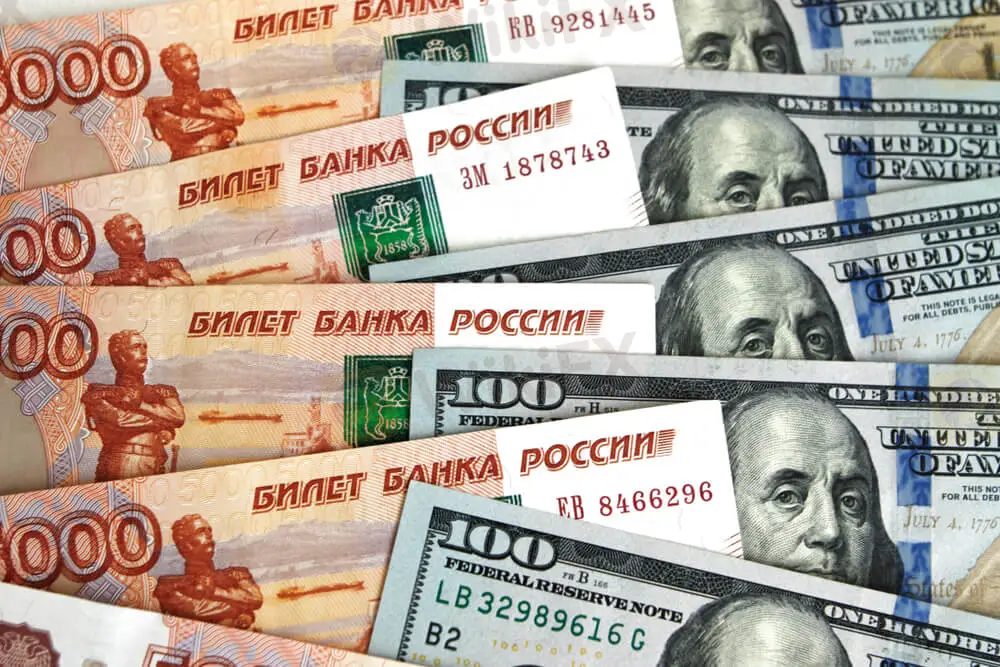简体中文
繁體中文
English
Pусский
日本語
ภาษาไทย
Tiếng Việt
Bahasa Indonesia
Español
हिन्दी
Filippiiniläinen
Français
Deutsch
Português
Türkçe
한국어
العربية
USD/RUB eases towards 102.00 even as US anticipates Russian hardships, oil retreat
Abstract:US anticipates Russia‘s economic, military weakness after the war with Ukraine, also hints at dearth and inaccuracy of Moscow’s missiles.

USD/RUB fades rebound from three-week low, pressured around intraday low of late.
NATO offers four battle guards to Ukraine for defense, Western leaders eye more steps to sanction Russia.
Australia, Japan join the West but China remains supportive of Moscow.
USD/RUB pares the biggest daily gains in two weeks around 102.50 during Fridays Asian session.
The Russian ruble (RUB) pair bounced off the lowest levels since March 01 the previous day as the US-led global alliances announced multiple measures to criticize Moscow‘s invasion of Ukraine. Also favoring the USD/RUB rebound was a pullback in oil prices, Russia’s key earner, from a fortnight high.
Senior US Official was quoted by Reuters saying, “Russia will emerge from Ukraine conflict weaker militarily and politically.” On the same line was a news piece from Reuters suggesting a lack of accuracy in Russias precision missiles and a likely dearth of the same in recent days. Furthermore, Australia and Japan also joined the West in sanctioning Russia.
On Thursday, US President Joe Biden pushed the European leader, the Group of Seven (G7) and North Atlantic Treaty Organization (NATO) members to announce more sanctions on Russia for its invasion of Ukraine. While his NATO friends could arrange battles guards for four of the Ukrainian cities and criticized Beijings ties with Moscow, the rest mostly refrained from major punitive actions against Russia.
That said, WTI crude oil prices took a U-turn from $116.61 the previous day, up 0.50% around $111.75 by the press time, as firmer US Dollar and Treasury yields weighed on the oil prices. Also challenging the energy prices are covid fears from China and Europe, as well as concerns that supply crunch will fade soon.
Amid these plays, S&P 500 Futures drop 0.15% intraday to 4,506, consolidating the heaviest daily gains in a week, whereas the US 10-year Treasury yields retreat from the previous daily close around 2.37% at the latest. It‘s worth noting, however, that Australia’s ASX 200 have so far managed to push back the bears but Japans Nikkei 225 prints 0.20% intraday losses by the press time.
Moving on, Eurogroup meeting and oil price moves may direct USD/RUB. Also important to watch is the Fedspeak and the second-tier US data.
Technical analysis
Unless crossing 21-DMA level surrounding 122.20, USD/RUB remains pressured towards the $100.00 threshold.

Disclaimer:
The views in this article only represent the author's personal views, and do not constitute investment advice on this platform. This platform does not guarantee the accuracy, completeness and timeliness of the information in the article, and will not be liable for any loss caused by the use of or reliance on the information in the article.
Read more

Why is there so much exposure against PrimeX Capital?
In recent months, PrimeX Capital, a Forex and CFD broker established in 2022, has become a subject of concern in the trading community. However, despite these enticing features, the broker's reputation has been severely tarnished by multiple complaints and a troubling lack of regulatory oversight.

The Hidden Checklist: Five Unconventional Steps to Vet Your Broker
Forex broker scams continue to evolve, employing new tactics to appear credible and mislead unsuspecting traders. Identifying these fraudulent schemes requires vigilance and strategies beyond the usual advice. Here are five effective methods to help traders assess the legitimacy of a forex broker and avoid potential pitfalls.

Doo Financial Obtains Licenses in BVI and Cayman Islands
Doo Financial, a subsidiary of Singapore-based Doo Group, has expanded its regulatory footprint by securing new offshore licenses from the British Virgin Islands Financial Services Commission (BVI FSC) and the Cayman Islands Monetary Authority (CIMA).

CFI’s New Initiative Aims to Promote Transparency in Trading
A new programme has been launched by CFI to address the growing need for transparency and awareness in online trading. Named “Trading Transparency+: Empowering Awareness and Clarity in Trading,” the initiative seeks to combat misinformation and equip individuals with resources to evaluate whether trading aligns with their financial goals and circumstances.
WikiFX Broker
Latest News
AIMS Broker Review
The Hidden Checklist: Five Unconventional Steps to Vet Your Broker
Russia to Fully Ban Crypto Mining in 10 Regions Starting January 1, 2025
YAMARKETS' Jingle Bells Christmas Offer!
Why is there so much exposure against PrimeX Capital?
MTrading’s 2025 "Welcome Bonus" is Here
Doo Financial Obtains Licenses in BVI and Cayman Islands
CFI’s New Initiative Aims to Promote Transparency in Trading
Currency Calculator


